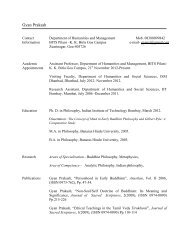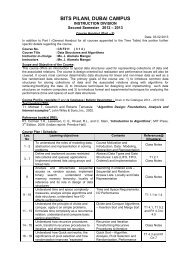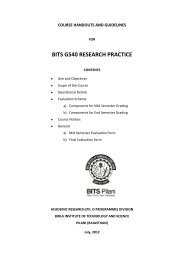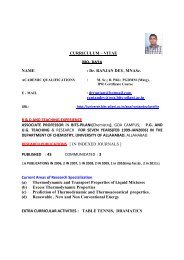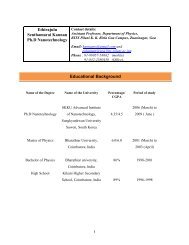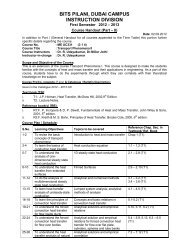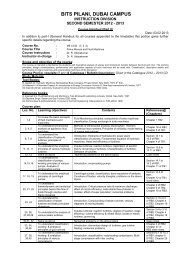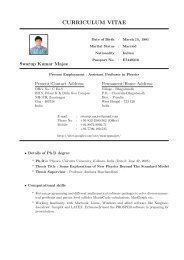associative entity
associative entity
associative entity
You also want an ePaper? Increase the reach of your titles
YUMPU automatically turns print PDFs into web optimized ePapers that Google loves.
Data Processing<br />
AAOC C311<br />
I Semester 2012 – 2013<br />
CLASS – 5<br />
Agenda:<br />
Understanding Degree and Cardinality with<br />
Examples<br />
© Prentice Hall, 2002<br />
1
Unary relationships
Binary relationships
Ternary relationships<br />
Note: a relationship can have attributes of its own
Basic relationship with only maximum cardinalities showing<br />
Mandatory minimum cardinalities
Optional cardinalities with unary degree, one-to-one relationship
A binary relationship with an attribute<br />
Here, the date completed attribute pertains specifically to the<br />
employee’s completion of a course…it is an attribute of the<br />
relationship
A ternary relationship with attributes
A unary relationship with an attribute. This has a manyto-many<br />
relationship<br />
Representing a bill-of -materials structure
Examples of multiple relationships – entities can be<br />
related to one another in more than one way<br />
Employees and departments
Professors and courses (fixed upon constraint)
Strong vs. Weak Entities, and<br />
Identifying Relationships<br />
Strong entities<br />
– exist independently of other types of entities<br />
– has its own unique identifier<br />
– represented with single-line rectangle<br />
Weak <strong>entity</strong><br />
– dependent on a strong <strong>entity</strong>…cannot exist on its own<br />
– Does not have a unique identifier<br />
– represented with double-line rectangle<br />
Identifying relationship<br />
– links strong entities to weak entities<br />
– represented with double line diamond
Strong and weak entities<br />
Strong <strong>entity</strong><br />
Identifying relationship<br />
Weak <strong>entity</strong>
Associative Entities<br />
<br />
<br />
<br />
It’s an <strong>entity</strong> Type – it has attributes<br />
AND it’s a relationship – it links entities together<br />
When should a relationship with attributes instead be an<br />
<strong>associative</strong> <strong>entity</strong><br />
– All relationships for the <strong>associative</strong> <strong>entity</strong> should be many<br />
– The <strong>associative</strong> <strong>entity</strong> could have meaning independent of the other<br />
entities<br />
– The <strong>associative</strong> <strong>entity</strong> preferably has a unique identifier, and should also<br />
have other attributes<br />
– The <strong>associative</strong> may be participating in other relationships other than the<br />
entities of the associated relationship<br />
– Ternary relationships should be converted to <strong>associative</strong> entities.
An <strong>associative</strong> <strong>entity</strong> (CERTIFICATE)<br />
Associative <strong>entity</strong> involves a rectangle with a diamond inside.<br />
Note that the many-to-many cardinality symbols face toward<br />
the <strong>associative</strong> <strong>entity</strong> and not toward the other entities
an <strong>associative</strong> <strong>entity</strong> – bill of materials structure<br />
This could just be a relationship with<br />
attributes…it’s a judgment call
Ternary relationship as an <strong>associative</strong> <strong>entity</strong>
ER Example : Question<br />
© Prentice Hall, 2002<br />
18
ER - Example<br />
© Prentice Hall, 2002<br />
19
ER - Example<br />
Course_<br />
Number<br />
Course_<br />
Name<br />
COURSE<br />
Is_prerequisite<br />
Units<br />
© Prentice Hall, 2002<br />
20
Next Lecture on ….<br />
Enhanced ER<br />
ER Question: A student works for a school<br />
that he/she attends. Assuming necessary<br />
attributes draw an ERD to model the<br />
situation.<br />
© Prentice Hall, 2002<br />
21




